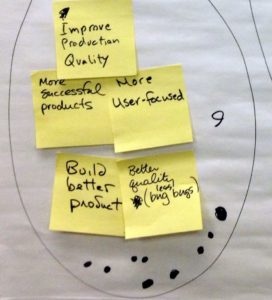A key success factor in any Agile transformation is understanding WHY Agile – why we want “Agile.” What do we really want?
Here is how to run a one-hour workshop to turn your “Agile” initiative into something valuable, sustainable and open the door for real change (transformation).
This may be the most important hour in your whole change effort.
Setup: One Hour to Clarify Goals
Get the senior managers and stakeholders together for a one-hour workshop to clarify the purpose of the Agile initiative you are leading or participating in or hope to undertake. Also consider including key influencers from the organization.
Remember that the higher up you go, the bigger the scope of possible change. See How to Build a Culture Bubble for why the choice participants is crucial.
Step 1: Ask Why Agile?
Give everyone sticky notes and sharpies and ask them to brainstorm Why are we doing this Agile Initiative? Ask people to work on their own for three to five minutes before sharing as a group.
I find with senior management, I usually need to explain How to go Fast with Sticky Notes. If they will not use sticky notes, then real change has little hope and focus on adopting Agile practices or use stealth Agile.
Step 2: Data collect around What, Why, How
Once they have finished writing sticky notes, set up three flipchart pages with labels What, Why and How. Ask them to put each sticky note on the spectrum made by these three words and cluster based on matching concepts. Circle each cluster. See diagram below.
Explain to people that we are using this model to help clarify thinking around why we are doing this.
As you can see from the photo, I sometimes add the label Outcome to help clarify meaning of “What.”
THE TRICK: It is really important to ask WHY when brainstorming and only during playback separate the reasons into What, Why, How.
Step 3: Explain What, Why, How
Here is my explanation:
- What/Outcome – This is about the result: what we want want to achieve. The outcome we are looking for as an organization.
- Why – The motivation for this undertaking. You may also see here leading indicators of success.
- How – This is about the mechanism or means that support getting to the outcome. How we actually do things.
Note: it doesn’t really matter where things go as long as it generally makes sense to participants.
Defend the What/Outcome. It is really important that the What or outcome only contains the end result that is sought after by this group. If it has means and intermediate elements, then expect unhelpful distortions in your initiative.
Step 4: Pick most important Elements
 Use dot voting to have them select the most important elements for this initiative.
Use dot voting to have them select the most important elements for this initiative.
Important: Have them vote in reverse seniority order to avoid hierarchical bias. See Highest Paid Person in the Room (HIPPO) bias problem for why this is very important.
Summarize the results to check for understanding: “So it seems like the outcome for this initiative is X and we see Y and Z helping us get there?”
Step 5: “Agile” is Not the Goal
Let them notice that Agile is gone! The outcome that they seek has nothing to do with Agile! Agile is not the goal.
Help them notice how Agile will help with the What, Why and How (if that is true).
Step 6: Replace the “Agile” Initiative with something else
Suggest officially dropping Agile as a goal and instead re-brand the initiative to focus on whatever their desired outcome was.
This will help people focus on the outcome, and not on “doing Agile.”
In a recent transformation, this turned out to be a key element in our success. Do not underestimate the value of a name and the stories we tell about ourselves.
Being Agile & Transformation
It probably seems scary to let go of Agile as an official goal.
It turns out that this is necessary to Stop Agile from being used as a Whip or a Shield.
My experience is that the only way we can really get to an Agile mindset is to let it arrive of its own free will. Coercing a system as an evangelist (I have done this) guarantees limited results.
If you love something, set it free.
If you want to learn more, come to one of our Certified Agile Leadership Trainings.




